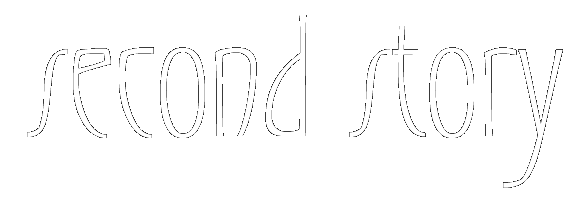Second Story – Thin Twisting Line Notes for Nerds
There can be a lot of reasons that conspire to make the process of creating an album take almost two decades. But there are also plenty of trivial tidbits along the way, and I thought it might be fun to share them with you. I say that it’s for “nerds” because a fair bit of it is technical, concerning equipment and process. But even if you’re not knowledgeable about those aspects of making and recording music, you might still be interested to find out some of this stuff about our 19-year journey to the completion of Thin Twisting Line.
Below, I (Mark, for the sake of narrative) have covered the process, equipment, ups and downs, and other details about our long-delayed recording and release of our second album. It’s largely from memory; we don’t have too much by way of notes or easily found archival information about the specifics, but I did find some helpful reminders using the “Wayback Machine” to revisit archives of our website from that time.
I hope you find it interesting. Let me know if I missed anything!
The Beginning – February 13, 2001
This long, strange trip began on February 13, 2001, when we blocked out a full week in a professional-grade recording studio to – presumably (and naively) – complete the album within that timeframe. Our previous album (recorded with Mike Ian at his Eyeball Studio, a part-time venture for him) had only taken a total of about 35 hours, including mixing. With a little overtime, we could easily spend almost twice that amount of time just in this one week. We were well-rehearsed and well-prepared, with a plan of attack and a clear vision. All five of us took a week off from our day jobs, and approached our recording session like it was a full-time job.
We ended up recording all of the tracks over several visits over close to a year’s time, but more on that as we move along.
Indre Studios, in Philadelphia, was a large-scale studio with a fabulous equipment list, great mic locker, and a massive tracking room (they held World Café Live concerts there for a bit.) On a side note, they no longer have the studio location, but Indre still exists as a remote recording service.
Interestingly, about two weeks before the blocked out time, we received a call from the studio manager – Patti LaBelle urgently needed to use the facility that same week, and would we be willing to “bump” for her? After speaking with her manager, we worked a deal – we graciously went through the process to reschedule five people’s weeklong vacations to accommodate her, and her people graciously paid for our 2” magnetic reels we’d need as part of our recording process (they were probably around a couple hundred bucks apiece, and we needed three of them.) Hence, we thank her in the liner notes for that “donation” to our efforts. Quid pro quo, baby.
Equipment Basics

Drums were recorded with lots of (too many) mics. Each drum was close-mic’d, and there was a pair of overheads, a room mic, and a distance room mic (again, the room was very big.) All the drums were recorded to the 2” 24 track reel to take advantage of the natural compression that tape provides. However, since the drums only required 11 tracks, we used half the tape, and used the 12th track for sync to the digital recorders. In this way, we could use each tape twice – tracks 1-12 for a couple songs, then rewind and use tracks 13-24 for two or so more songs.
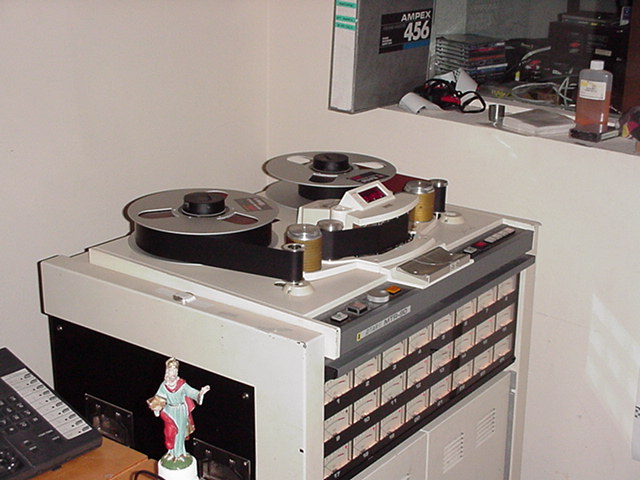
The massive 2” machine synced up to a trio of DA-88/DA-38 digital audiotape machines, which each did 8 tracks. So we had an additional 24 tracks available in the digital domain for recording the guitars, basses, keyboards, vocals, and other elements, for a total of 35 tracks available for individual elements in each song. That sounds like a lot, but things recorded in stereo (like piano, keyboards, some of the specially effected guitar parts, etc.) would use two tracks each. So on some songs, available tracks for new elements could get kind of scarce pretty quickly.
That said, there were only a couple songs that actually used all of the available tracks, and in fact the simpler songs (production-wise) used far fewer. During the tracking sessions, the engineer also did a 4-track quick temporary mix (to the digital tapes) of the drums, with kick, snare, and stereo pair of the rest of the kit, allowing us to turn off the 24-track machine. We played along with this scratch mix of the drums while recording the rest of the instruments and vocals. This saved time (we didn’t have to wait for the 24-track reel to rewind, or sync up to the digital media) and also prevented unnecessary wear and tear on the very expensive reel-to-reel machine – not to mention the tape media itself.

All of the songs on Thin Twisting Line were recorded to a click track – in fact, we had a click as well as a cue track. I chose the sounds for the click to be distinct and easy for us to hear and follow. If given the chance to go back and change anything, I’d alter the sounds used for the click, as the main pulse was done with a cowbell-like “tink” sound — occasionally, I can hear a little bit of it in the final mixes leaking from a headphone mic. A rookie mistake on my part, to be sure. But even other members of the band say that they don’t hear them, so maybe I’m just overly sensitive. I’d also minimize the cues on the cue track, to be merely “landmarks” rather than semi-complete parts; I think the parts I created were more of a distraction than a help. But again, hindsight is 20/20, as they say.
Drums
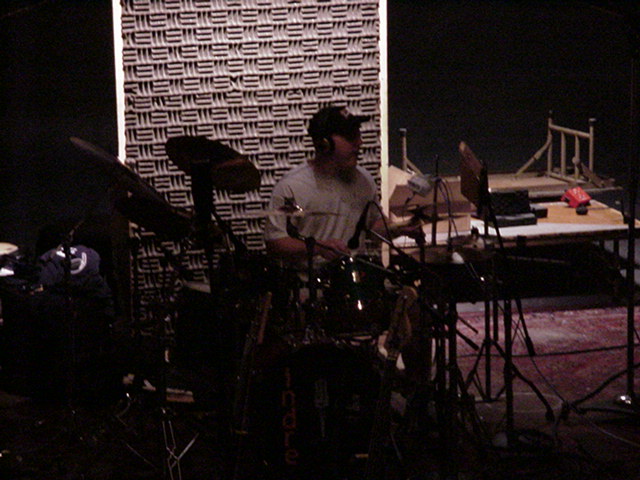
We started by focusing on the drums in that first block of sessions; we recorded scratch tracks of the other basic instruments, all in the same tracking room and using our live gear. Tom was a real trouper; not only was it hard work, but he was playing through an elbow injury which made playing rather painful. Regardless, he got behind the kit and pretty fairly tore it up, and we captured some really incredible drumming on the album.
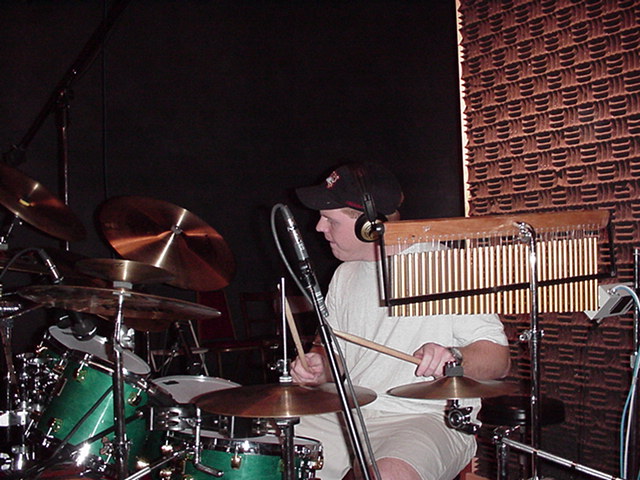
Over the course of about four days, we got those tracks recorded (there were breaks in the action for fill-in recording by other band members.) But it wasn’t all drums, all the time – we took breaks and did some other stuff in between to give Tom a breather (and his elbow a rest.)
He did end up having to re-record a couple of the songs later in the week – we discovered that the tempo of Wrapped in the Arms of Mountains wasn’t “peppy” enough, and there were some issues (not his fault) with the pulse/feel of Dancing on the Hill as well.
Tom brought his Yamaha Maple Custom drum kit and his own cymbals to the studio. As to heads, sticks, cymbals, you’d have to ask him.
Basses

On day three, I broke down my bass rig and took the preamp/head unit upstairs to the control room to track the basses. Most of my bass sounds were done with my live rig, run on an XLR out of my preamp’s DI directly to the mixing board. My preamp at the time was an ADA MB-1 rack-mount pre with upgraded tubes, and for outboard effects I used a DBX Subharmonic Synthesizer (think a more subtle octave divider) and a Peavey Analog Filter. Distortions were provided by the ADA’s programs.
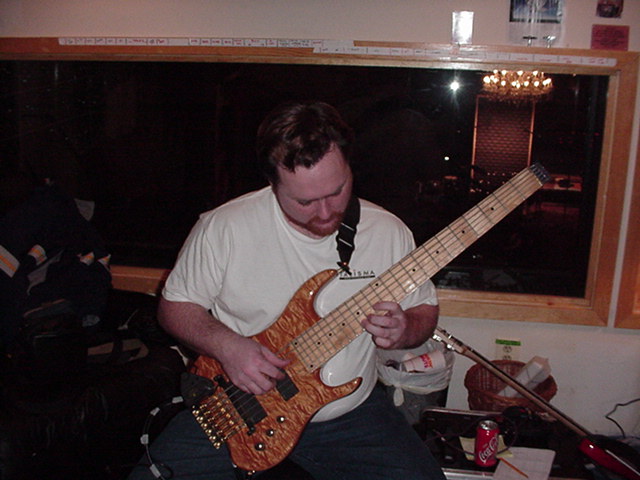
I primarily played my main bass – a PBC 356GTB six-string fretted bass that was my primary instrument for Second Story performances. On a couple of tracks, I used my custom 6-string Hoyt fretless (opening line on Autumn, the entirety of Light and Silence). For Truth Is… I used my 12-string bass, played with a pick. And for Wrapped in the Arms of Mountains, I played a $100 Squier P-Bass that I had at the time – and ran it through a Tech-21 SansAmp DI (the only song I didn’t use my rig for).

Also of note, I used my MIDI bass setup, employing an Axon hex pickup and a Yamaha G50 to trigger my sound bank – an Alesis Nanobass – for some of the atmospheric keyboard bass parts (most apparent in the verses of Clay.) And, of course, I used my “Funk Fingers” – miniature drumsticks that strap to my two main plucking fingers – for the aggressively percussive bass parts in Abducted and Dancing on the Hill.
Most of my parts were recorded on this day, but for reasons of workflow, I recorded the twelve-string bass on day six for Truth Is, and the two songs that Tom had to re-record drums for (Wrapped in the Arms of Mountains and Dancing on the Hill) on day seven.
Guitars
Scott brought lots of amp and instrument options when it was time for him to record his guitar parts, which started on day four. Most normal guitar sounds were recorded “dry” (without effects) so that we could make production decisions for the guitars as we mixed. But the truly “signature” sounds were from his live rig, and were recorded with their effects direct to tape; the slapback/detuned guitar part in Vicariously is an obvious example, as are specially designed sounds like the ones in Truth Is… and The Silent Giants. His live rig consisted of a Rocktron Chameleon preamp, with an Alesis Quadraverb 2 for outboard effects. And he used his MIDI triggering setup (Godin three-voice guitars triggering an Axon AX-100 converter/soundbank) in songs like Clay, for the syncopated cello line in the choruses.
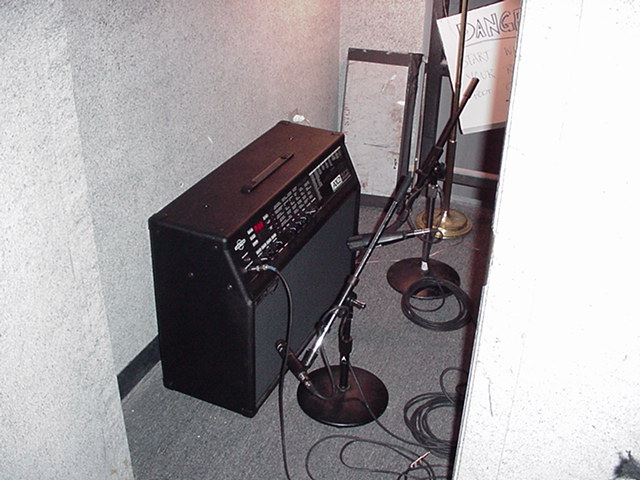
For more typical guitar tones, he also brought other amps into the studio, to increase his tonal variety (and quality). He dragged in a Line6 2×12 combo, as well as borrowed a friend’s Fender tube combo for some of the most “naked” guitar parts – its warm, tube-y sound really gave life to songs like Dishonest. Tracking was done with Scott in the control room, running a cable under the door into his amps, which were mic’d just outside the room. The hallway had just the right level of damping and openness to get rich, open, realistic guitar sounds.
Many of the electric rhythm guitars were double-tracked, in order to get that wide, stereo imaging and full-bodied sound. In retrospect, this was probably overdoing it, and probably unnecessary, but it was a common practice at the time, particularly in music that was as “densely” produced as ours is. With 20/20 hindsight, we’d probably have skipped that step and saved a good bit of time and effort during the tracking process. In our final mixes, quite a few of those double-tracked guitars ended up getting muted.
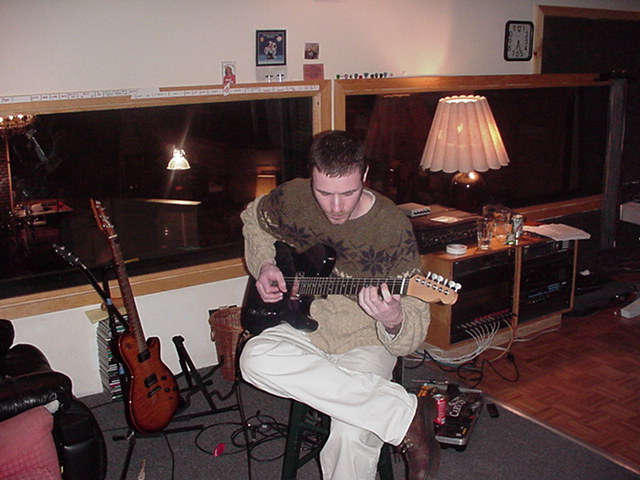
As for guitars, he brought his main live guitars – Godin LGX models – for much of the tracking, also bringing along his trusty Ernie Ball Music Man Silhouette for a few of the songs. He also borrowed a friend’s Tele-style thinline guitar for a track or two. As for acoustics, when we got to them, they were recorded in the main tracking room with microphones; they included his Takamine Santa Fe series nylon-string, steel-string, and 12-string guitars.
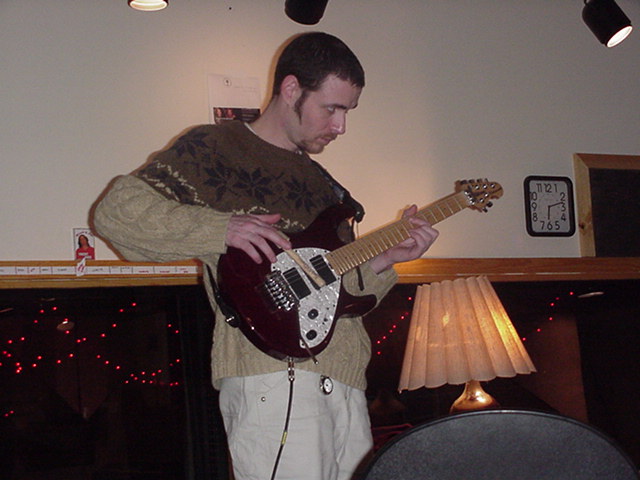
Most of Scott’s parts were recorded exactly as he played the songs live; philosophically, we liked not “over-producing” too much by adding parts that weren’t usually there. But we did indulge a few fun small additions; for example, he added a couple subtle guitar harmonies (in the short tags on Dancing on the Hill) and used Mark’s “Funk Fingers” to place some chiming harmonics into the choruses of Vicariously.
Scott recorded most of his electric guitar parts on days four and five in the first session, but we had to go back for a short session to do one other guitar solo, one electric part, and the acoustic guitars for the entire album.
Keyboards
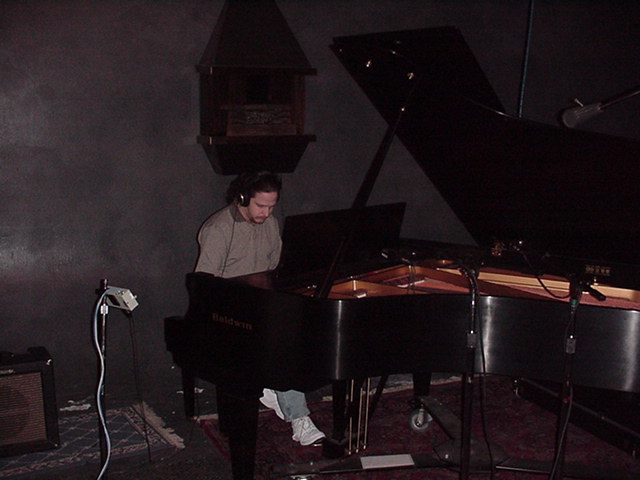
Day six was John’s chance to shine. All of the pianos were recorded in stereo on the beautiful Baldwin grand piano that they had at the studio; it was tuned the week before our session. That piano (and John’s skillful playing of it) provides wonderful depth and grandeur to the songs where it is used — and particularly those where it takes center stage, like Dishonest and Autumn.
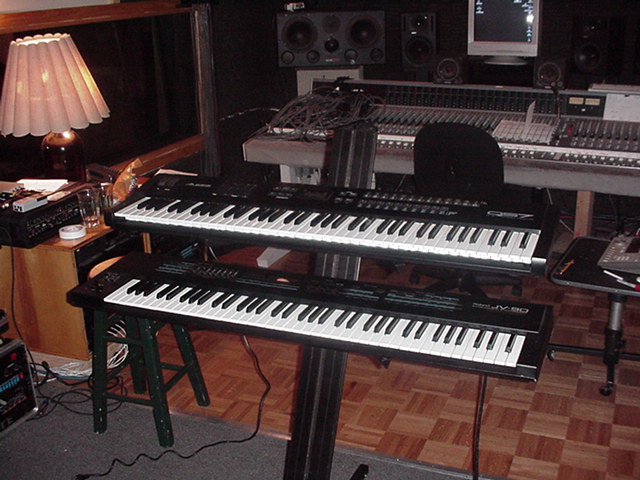
John’s other keyboard parts, and all his keyboard solos, were recorded direct to the board in the control room. He used his live rig – a Roland JV-90, an Alesis QS7, and a Roland JP-8080 (which he leaned particularly heavily on, having created many custom patches on it for our songs).
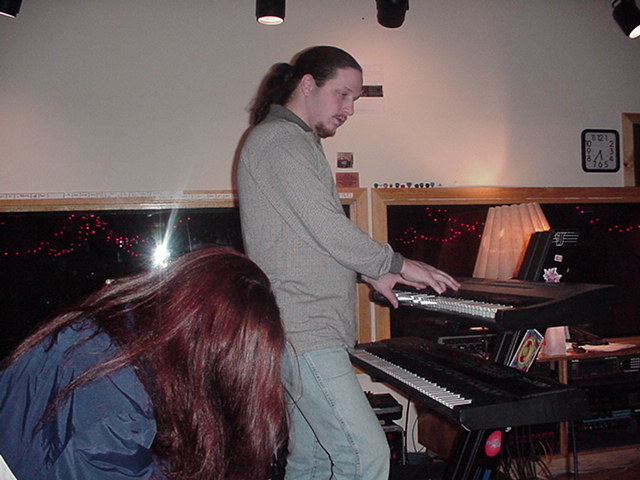
Like Scott and I did with our parts, John kept his parts (and our own) largely the same as he performed them live, rather than heavily augmenting the recording with new, added “atmosphere” via overdubs. So he pretty much played his parts “straight,” and as a result he knocked them out really quickly, like a pro.
Vocals

The only vocals recorded during the initial tracking sessions, unfortunately, were the scratch vocals we recorded to ensure that we kept our place and were making good production decisions. We’d later return in additional sessions to get the final recordings of Danielle’s leads and our backups.
Other Instruments
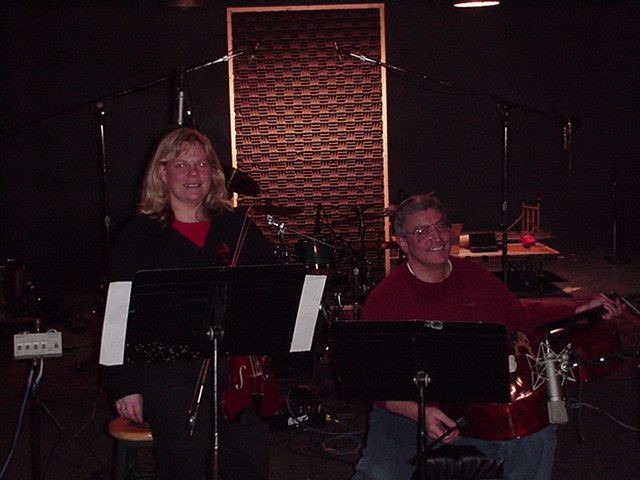
On day three, we took a break from our parts and invited our guest musicians into the studio to record the “string quartet” and French Horn parts in Clay. Amy Patton Weckesser (violin) and Tony Gizzi (cello) arrived and recorded together, and worked out and recorded their parts in the course of about an hour. Amy played each of the three violin parts in succession, overdubbing each new harmony atop the last, to get the opening staccato part of the breakdown, which is the part that John would normally play with his keyboards in our live perfomances. Tony worked out the flowing cello line (normally played by Scott on his MIDI guitar) and we even made a minor change to improve the line, as I recall.

Later, Amanda Smith came in to record the French Horn part (that I would perform live using my MIDI bass). Her skill and professionalism really came into play – as my transcription skills were rusty, I’d made an error transposing her part and it was written out in the wrong key. She figured it out, transposed on the fly, and nailed her part in 1-2 takes. As a former French Horn player myself (in high school) I was humbled by her amazing tone and control.
Danielle had a couple of songs that feature her playing her flute, a lovely Yamaha Professional model. She recorded the part for Clay during the same session as our guests came in, because we had mics set up and wanted to hear it all fully realized. Among the other songs that feature flute parts are Autumn, Shooting Star, and Dishonest – they were eventually recorded in a later session when we returned to the studio.
Takeaways from the First Session
So, we figured that we’d be DONE after a 7-day, 10+ hours per day session at a professional studio. As it so happened, we still had a lot to do – all of the vocals and acoustic guitar parts, a few rhythm guitars and solos, and most of the flute parts still needed to be recorded. And much of those, of course, are some of the more difficult to “nail,” and therefore take more time and repeated attempts to complete.
To make matters more complicated, the Tuesday following that week-long session, two of had unexpected employment changes. This meant that money got tight real quick, and since going into a pro-level studio costs a lot of money, things progressed very slowly until we were able to regroup, financially.
Followup Sessions

In June of 2001, we returned for another session. This one mainly had us getting the rest of Scott’s guitars recorded – the acoustics, and what was left of his solos. Scott adeptly cut the remainder of his parts in a single 8-hour session, leaving only vocals and a few flute lines left to do.
In subsequent vocal sessions in August, Danielle performed her parts effortlessly, using some of Indre’s top-shelf large-diaphragm condenser mics, and gobos to help “tame” reflections in their giant tracking room. The songs, by this time, were very familiar (we’d been performing all of them regularly at gigs throughout the region) so very little preparation or practice was necessary – she just went out to the mic, and knocked ‘em out like a pro.
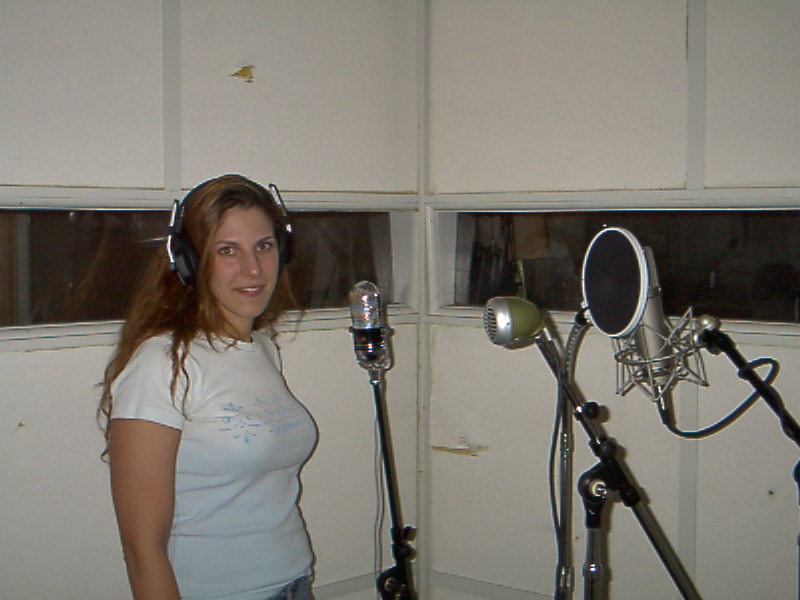
Likewise, John, Scott, and I were able to record our backing vocals quickly and efficiently as well. Again, our philosophy was to make it rather similar to what we did live, and we made very few changes – the most notable was to have Danielle sing her own backups in a couple choice spots, which we thought was a better decision from a tonal perspective on those particular passages.
The primary engineer (and his assistant) who did our main session block wasn’t available, so we had a couple of other of Indre’s engineers helping out with these vocal and guitar recording sessions.
So we did eventually finish up the recording process, a little less than a year after we first entered the studio. At that point, we got some rough mixes and started taking notes for the final mixing sessions.
Mixing
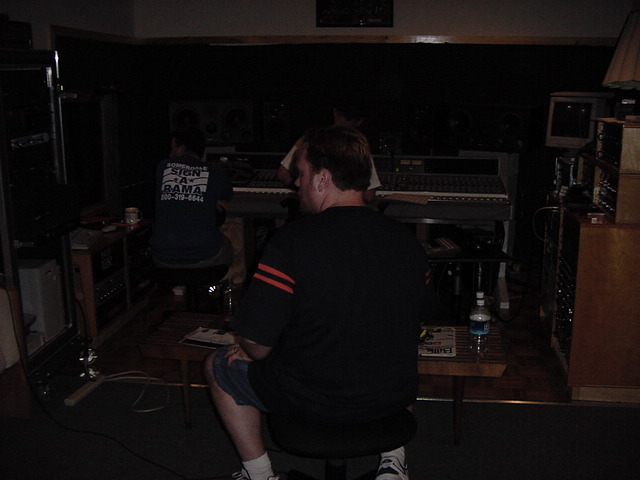
Among the ways we raised the funds to finance some of these sessions was to help the folks at Indre bring in a new piece of gear – an amazing SSL mixing board (which weighed over 1000 lbs, and we had to get it UPSTAIRS to the tracking room.) The new board should have benefited our project immensely, though, because it offered a level of automation (and sound quality) that the previous board was incapable of. Considering the complexity of some of our mixes, that automation would be particularly helpful. They’d also switched to a RADAR recording system, so our original tapes were transferred to that medium for the mix-down. But, even with this improvement in workflow and capability, it ultimately ended up not being enough to get the results we were hoping for.
I won’t get into specifics, but we were very disappointed with the mixes we ended up with. I shoulder some of the blame, as my extensive measures of preparation probably made a good bit of our process needlessly complicated; I’m sure that some of it subsequently made our songs harder to mix. Also, it was recorded over several sessions; therefore, multiple engineers (who each have their own process, quirks, etc.) had their hands in the source material. And the passage of time between the sessions made it hard to remember specific intentions and processes that had occurred during tracking. It had taken a year and a half to get to this point – so none of it was “fresh” to anyone’s ears. There was some impatience and anxiety about it having taken so long (and cost so much) by this time, too. Finally, I really just think that the main engineer, while quite skilled and experienced (he has several major label releases under his belt) was probably just not the right guy, stylistically, for our unique brand of music.
All of that to say, once we got the mixes home, we quickly realized that we couldn’t release it as it stood – it was dull and lifeless, even a bit disjunct sounding. It simply didn’t represent our sound, and we needed to fix it.
Another Studio
We tried to get right back on the horse as soon as we could. Through a friend, we knew another skilled audio engineer who had his own studio that we could work with; he also had extensive experience in less “typical” genres of music, so we figured he’d speak our language, sound-wise. He even already used a RADAR system in his studio, so it was a simple matter of bringing DVD-R backups from Indre to import into his rig.
So we went in for several mixing sessions at his studio, and got new mixes of the tunes with him. They were a lot closer – some of the less complex songs, like Light and Silence and Dishonest actually sounded pretty good. But again, there was a failure to capture our “vibe” with most of the other songs. Tunes like The Silent Giants sounded sterile, and Autumn – a signature song for us – was uncharacteristically flat and lifeless. And some of the more complex songs like Clay and Dancing on the Hill? Well, they were just a mess.
Second Story Disbands, Progress Continues (But Slowly)
With the album remaining unfinished and unreleased, we played our last gig (although we didn’t know it at the time) on June 5th, 2004. Despite the band no longer being active, it became a matter of pride to keep trying to find a way to complete what we had started – after all of the money, time, effort, and heart that went into the album, we just had to find a way to finish it.
With that in mind, about 10 years ago, I took the two-inch reels down to Tony Mascara’s studio in Cumberland County so that he could convert the tracks to digital so that I could import them into my DAW in my own home studio. I purchased my own used DA-38 machine, and used it to digitize the original 8-track digital tapes so I could combine everything in one place. I lined up the tracks and put the songs together in the hopes that I could mix it myself, since I had unlimited time and labor (I didn’t have to pay hourly studio rates, and could work on it whenever I had the time and inclination).
Over a decade of working on it, in spurts, I achieved modest success in getting some decent sounds; but while I have the professional tools, I just don’t have the experience to efficiently make the right decisions to make effective corrections and improvements. It was a frustrating experience, as there is just too much trial and error when you’re not a practiced, working studio engineer. So, although I was able to muster a couple of decent mixes, I really wasn’t much happier with the results than I’d been before.
August, 2019
And that’s what brings us to the present. Scott and I got to talking about how it still killed us to have the project not be finished at this point, so many years later. It was Scott who suggested that we contact our old buddy Mike Ian (aka Mike Ianieri), who had recorded and mixed our first, self-titled album back in 1997. That album had always sounded stellar, but for a variety of reasons, he was unavailable in 2001 (and a while after) when we were ready to record our followup.
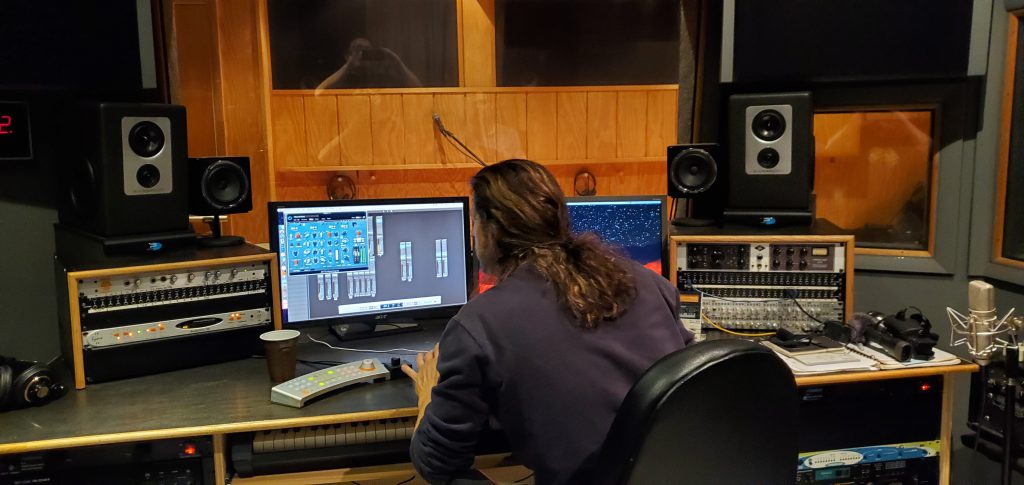
So we dropped him a line. He was excited to take on the project, and we worked out the details, gave him the backstory, and sent him the files. Over the course of several months, he hit his studio, tweaked the sounds, made refinements, and improved sync between some of the tracks that had “drifted” when being combined from different sources. It was a LOT of work, but the extra dedication was clearly a big difference maker when it came down to the end result. He put the time and effort in, and it really shows. Thanks, Mike.
He also made some strong (as well as subtle) production suggestions and decisions, always listening to our thoughts, and giving us veto power. Scott and I emphasized that it was our philosophy to preserve as much of our original sonic/production intent as possible, while taking advantage of some of the newer tools and effects available to us today – and he stayed within that framework, only gently pushing the envelope to help us maximize its potential. All along, we were exceedingly careful not to step on our bandmates’ toes by not fundamentally changing any of their performances, and only “added” a few minor, textural things to provide a bit of fresh new “color” to the sound.
It was a careful tightrope to walk, as there were certainly ripe opportunities to totally revamp things, but we wanted to remain true to our vision from 2001. And we feel that we did just that, but provided a few “Easter Eggs” that bring some modern relevance and a contemporary vibe to the album.
Voices [2019 Version] and the Self-Titled Album
Scott and I decided that – since we were finally going to create a commercial release of the album – it might be worthwhile to include our original self-titled album as part of the package as well. We could re-master it to bring it more in line with the “new” album, and even include a bonus track of our cover of the Queensrÿche song, One and Only. We had recorded that song with Mike Ian, back in 1999-2000, to be included on a tribute album to the band. Since that album was never released, we looked into the costs of licensing the cover song, as well as the cost of adding a second CD to the duplication package. Neither cost was prohibitive, so we decided to do that, to make for a more complete “discography” type release.
On the side, Scott had often mused about re-recording the song Voices from the self-titled album, to have it sung by Danielle (rather than me, as it was on the original release) for a more consistent vocal throughout the album. So, behind his back, I went to Mike’s studio (he still has the original ADAT tapes from the sessions in 1996-1997, and I have an ADAT machine) and imported the original tracks from those sessions into a format that I could use in my studio. I then invited Danielle over for a quick, secretive vocal session, and we re-recorded the lead vocals, and I added some new orchestration to freshen up the song.
Danielle really nailed it, giving the song a new, spookier character, and bringing a fresh perspective to the lyrics – and the new instrumental elements gave it a more dramatic sound. A couple days later, I had the opportunity to surprise him with the new version of the song, and it was a go; we now had two “bonus” tracks of never-released material to add to the remastered version of the self-titled album.
Mastering
Once we’d finished the mix – which was a very exciting moment – we knew that the next step would be mastering. Initially, we sent the mixes to a musical friend who does commercial mastering in his studio (where he’s recorded/mastered quite a few albums for his well-known band and his own side projects, among others). His musical forte was more within the hard rock genre, but we figured we’d give him a chance at it. Unfortunately, when we got the masters back, we decided that – while they sounded good – they weren’t quite hitting the mark. We figured that we’d come too far and waited for too long to blow it in the mastering stage, so we passed on those masters and sought out another option.
We were referred by Mike Ian to Tommy at The Mastering House – he ended up taking on the project, and in a very collaborative process, provided us with exactly the sound we were looking for. He quickly mastered Thin Twisting Line, and took a bit more time with Second Story, as it was a fair bit trickier to take 23-year-old source tracks and bring a more modern, punchy style to their production.
If it were possible, we would have even considered re-MIXING the original album, as the original media was still available to us, and the tracks were still viable. But we realized that, due to track count limitations when we recorded the album, all of John’s keyboard parts had been captured via MIDI on a separate machine, and synced to the recorded tracks during mix-down. So since no actual audio recordings of the original keyboard tracks exist for those performances, and the sync machine is long dismantled (and the MIDI tracks therefore lost), all of the piano and synth parts would have to be re-created from scratch. So that was a non-starter, as far as a remix goes.
CD Production
The artwork was created by my friend John Lopes; he’s a talented professional graphic artist who did a wonderful job taking our vague conceptual ideas, filtering it through an understanding of our stylistic tendencies, and turning it into an utterly fabulous final design. The “bridge” concept was something that the band had always envisioned for the cover – “Thin Twisting Line” is taken from a line in the lyrics from the song The Silent Giants, and is a poetic allusion to the bridge(s) into the city. It made for a nice local call-out to feature the distinctive Ben Franklin Bridge and the stylized Philadelphia skyline in our release; it really nicely ties us to the region where we played so many shows and honed our sound.
As to the audio, with Scott’s assistance, I sequenced, cross-faded, and indexed the master CDs for duplication in my home studio, including putting a “hidden track” on the Self-Titled bonus CD (you’ll just have to look for it!) We submitted the materials to DiscMakers in Pennsauken NJ for the final production in late January.
Completion… Finally!
And on February 13th, 2020 – coincidentally, EXACTLY 19 years to the day after we first entered the studio, I picked up our first run of production, retail-ready CDs for the Thin Twisting Line project.
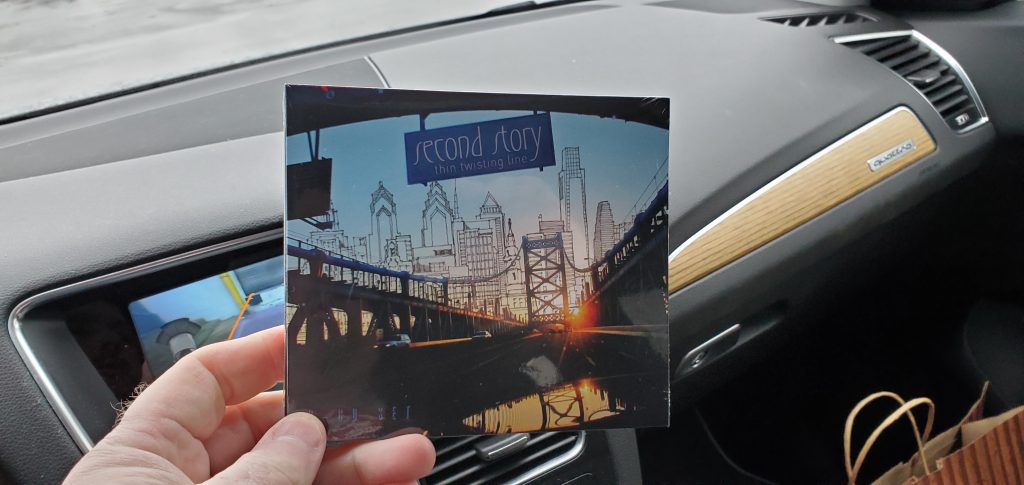
First one out of the box 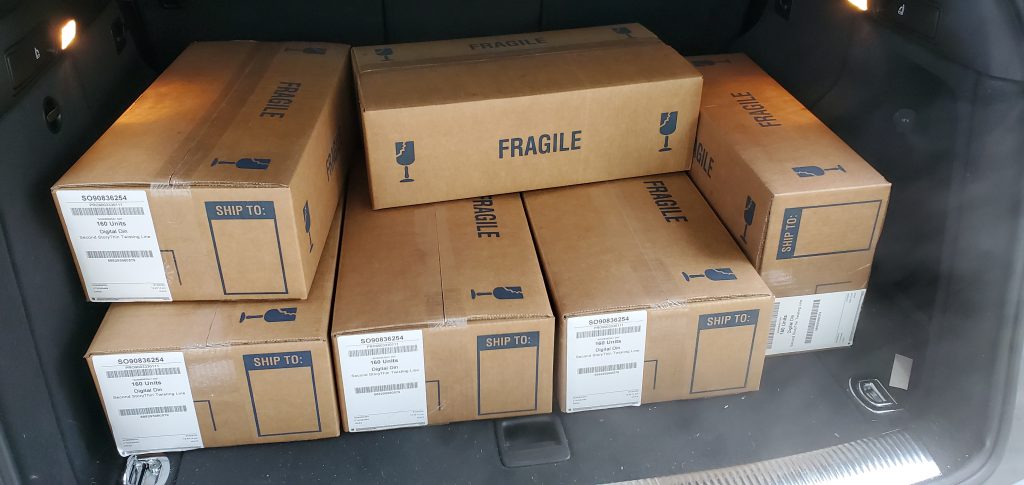
That’s a lot of CDs!
So yeah, a long, strange trip it has, indeed, been. But we finally have closure, and a complete project that we can feel exceedingly proud of. Though the recordings are 19 years old, the completed album sounds and looks current, fresh, and contemporary. And our music still defies comparisons – it’s a great challenge to find “sounds like…” artists when people ask.
Whether it was really worth the cost and the effort to finish this project is a pointless question to us. Having a tangible, completed album after all this time fills a void we’ve all had for a long time, and now that void is filled. We’re excited (and more than a bit relieved) to finally bring this music to you. We hope you enjoy it.
